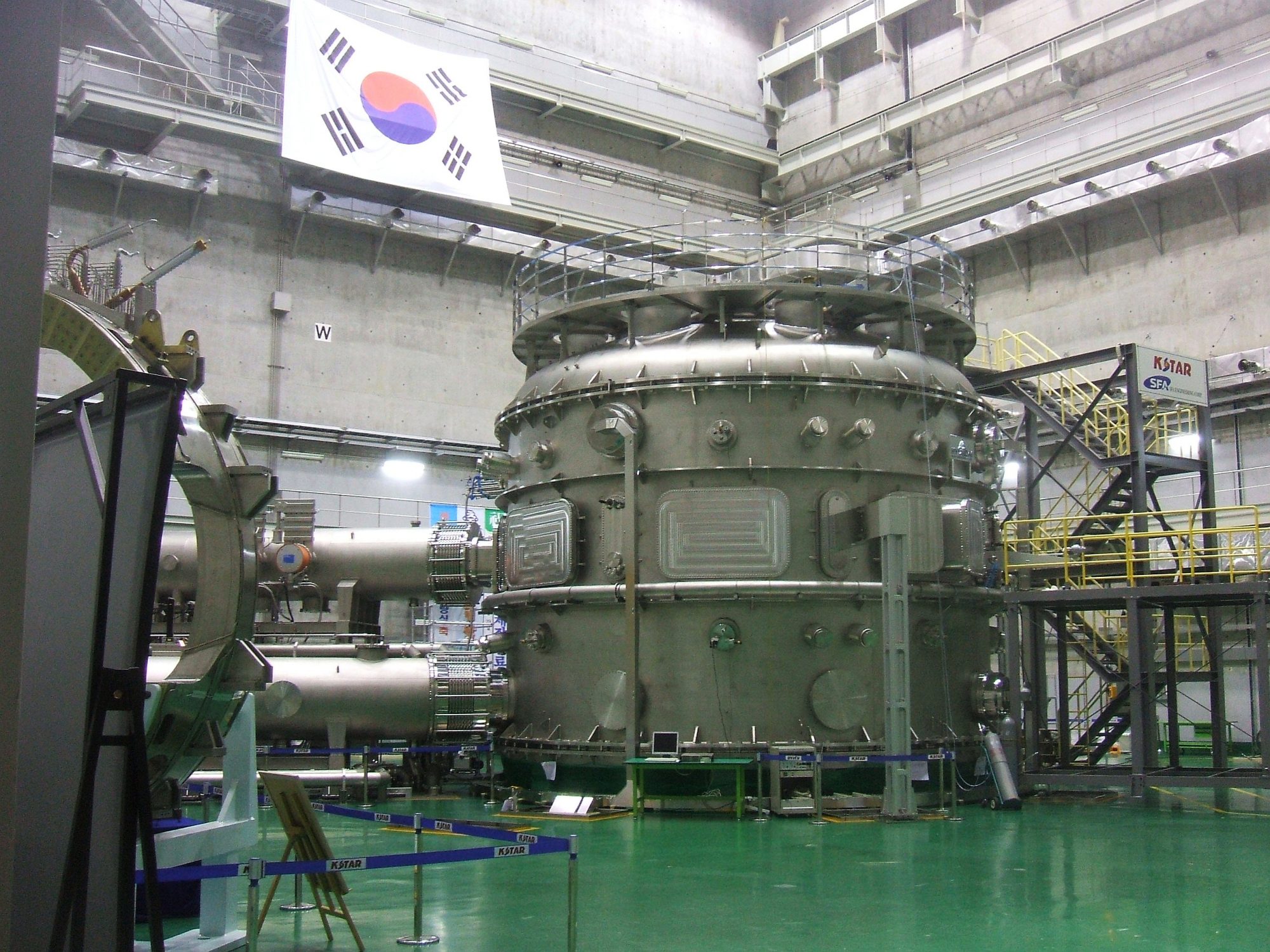Researchers at South Korea's Korea Superconducting Tokamak Advanced Research fusion reactor (KSTAR) have had another breakthrough. By swapping out some components inside their tokamak, they more than doubled the duration of their previous high mark for maintaining a cloud of the hottest substance anywhere in the entire solar system. For most of a full minute, inside of a towering cylindrical reactor, the incandescent breath of God was grasped and held by humanity in a radiant swirl of unfathomable heat and energy. It is an absolute travesty that no one involved thought to carve out 10 or 15 of those seconds to lift me by the ankles and hammer-throw me into the cloud, so that I could be consumed by the light and utterly eradicated in a brief waft of sparkling dust.
Hydrogen fusion, of the sort being researched by both magnetic confinement reactors and inertial confinement reactors around the globe, works by smashing hydrogen atoms together in such a way that they join and form heavier atoms, casting off tremendous amounts of energy in the process, energy which in theory should be easy enough to capture and to direct into the operation of a countertop toaster oven. Self-sustaining fusion reactions use the energy generated by fusion to produce more fusion; scientists working on this project hope eventually to create the conditions for self-sustaining fusion reactions that produce more energy than they require in thermal input, which would open up possibilities for clean and abundant commercial energy. The scientists doing these experiments are extremely optimistic about this goal. In fact, in 2022, researchers at the National Ignition Facility in California achieved breakeven using inertial confinement fusion, a reactor type that compresses fuel inside history's coolest thimble and then kerplodes it with 192 lasers.
But in all that fusioning inside a burning plasma cloud, other stuff is created: heavier byproduct ions, which float around in the stew and screw up its properties and cause it to burn less efficiently. Researchers working on magnetic confinement fusion inside tokamak reactors—donut shaped devices that use mind-bogglingly powerful magnetic fields to suspend and agitate a hydrogen plasma hot enough to singe the divine nose hairs of God—use a mechanism called a divertor, which exists to pull waste gases and impurities (ash) out of the plasma cloud, minimizing contamination and protecting the more sensitive parts of the reactor. Magnetic forces expulse (there's a cool word) these impurities—my atomized remains, theoretically—through a narrow gap in the field, called a separatrix (another cool word), in the direction of divertor targets, which are remote from the plasma reaction itself. The more effectively the waste byproducts are explused through the separatrix, the hotter and more efficiently the plasma burns, and the better it can sustain atomic fusion.
KSTAR divertors, for many years, were composed of carbon. The carbon divertors worked great! Back in 2020, KSTAR researchers set a new world record when they sustained for 20 seconds a stable plasma cloud burning at an astonishing 180 million degrees F. Don't you dare sneer at this! The core of the literal Sun—that one, the one up in the sky that warms our atmosphere, turns the plants green, and overwhelms your pathetic eyeballs, causing you to wear sunglasses—burns at about 27 million degrees F. KSTAR researchers created a cloud seven times hotter, and then they prevented it from vaporizing half of the planet, and then they held it that way for approximately five times longer than the average NFL play. What did you ever do that compares with this, you piece of shit?
But these already deity-like researchers were not satisfied with this incredible cosmic power. Recently, according to a report from Interesting Engineering, they made the decision to upgrade the divertors to tungsten, a naturally occurring rare metal notable for having the hottest melting point of any known element, over 6,000 degrees F. These new tungsten divertors allowed KSTAR, in a series of tests held between December 2023 and February 2024, to maintain that 180-million-degree plasma for a whopping 48 seconds, and to run the device's high confinement mode (H-Mode) for 100 seconds. This is considered of vital importance to similar tokamak projects: Researchers building the humongous ITER tokamak in France—approaching boondoggle status 11 years into its construction, with at least one more to go—intend to use tungsten divertors in the completed reactor.
Fusion researchers are steadily zeroing in on maximum reactor efficiency. One day there will be a tokamak that combines the astounding magnetic forces of the SPARC reactor with the heat tolerance of KSTAR's new tungsten divertors and the super-duper non-malevolent plasma manipulation skills of DeepMind artificial intelligence to create a chamber capable of holding in lengthy suspension a perfectly tuned and optimized blob of hydrogen plasma, radiating with such incomprehensible power and beauty that humankind gains utter dominion over the entire universe. I do not ask for control over this blob. All I ask is that I be loaded into a large slingshot and fired headfirst into the brilliant Cloud of Creation, so that in a flash I am singed out of existence and my ultra-fine ash expulsed smoothly through the separatrix, to later be vacuumed lovingly from the surface of several divertor targets.
H/t Rory






